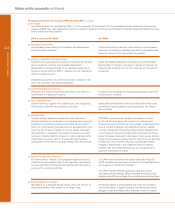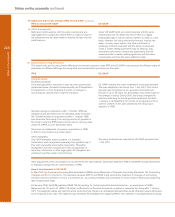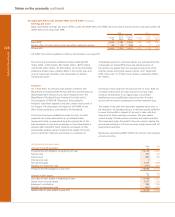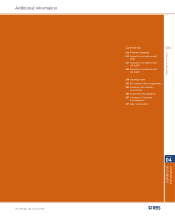RBS 2005 Annual Report Download - page 228
Download and view the complete annual report
Please find page 228 of the 2005 RBS annual report below. You can navigate through the pages in the report by either clicking on the pages listed below, or by using the keyword search tool below to find specific information within the annual report.
226
Notes on the accounts
IFRS or relevant UK GAAP
(k) Offset arrangements
Debit and credit balances with the same counterparty are
aggregated into a single item where there is a right to insist on
net settlement and the debit balance matures no later than the
credit balance.
IFRS
Intangible assets
Purchased goodwill
Purchased goodwill is recorded at cost less any accumulated
impairment losses. Goodwill is tested annually (at 30 September)
for impairment or more frequently if events or changes in
circumstances indicate that it might be impaired.
Goodwill arising on acquisitions after 1 October 1998 was
capitalised and amortised over its estimated useful economic
life. Goodwill arising on acquisitions before 1 October 1998
was deducted from equity. The carrying amount of goodwill in
the Group's opening IFRS balance sheet was its carrying value
under UK GAAP as at 31 December 2003.
There was no restatement of previous acquisitions in 1998.
In 2004 no amortisation was written back.
Other intangibles
Until 2004 intangible assets acquired in a business
combination were recognised separately from goodwill only if
they were separable and reliably measurable. Thereafter
intangibles have been recognised if they are separable or
arise from contractual or other legal rights. All intangibles are
amortised over their useful economic lives.
US GAAP
Under US GAAP, debit and credit balances with the same
counterparty may be offset only where there is a legally
enforceable right of set-off and the intention to settle on a net
basis. However, fair value amounts for forward, interest rate
swap, currency swap, option, and other conditional or
exchange contracts executed with the same counterparty
under a master netting agreement may be offset as may
repurchase and reverse repurchase agreements that are
executed under a master netting agreement with the same
counterparty and have the same settlement date.
US GAAP
US GAAP requires the same treatment of purchased goodwill.
This was adopted by the Group from 1 July 2001. Prior to this
goodwill was recognised as an asset and amortised over
periods of up to 25 years. No amortisation was written back on
this change of policy. During 2005, the Group changed the
date for performing its annual goodwill impairment test from
1 January to 30 September for certain of its reporting units in
order to conform to the date selected by the Group upon
adoption of IFRS.
The same treatment was adopted for US GAAP purposes from
1 July 2001.
(3) Implementation timing differences
This section sets out the areas where differences in amounts reported under IFRS and US GAAP arise because the effective dates of
standards are different although the recognition and measurement principles are the same.
Other adjustments in the reconciliation of net income for the year ended 31 December 2005 from IFRS to US GAAP include refinements
to estimates arising from the implementation of IFRS.
Recent developments in US GAAP
In May 2005, the Financial Accounting Standards Board (FASB) issued Statement of Financial Accounting Standards 154 ‘Accounting
Changes and Error Corrections’. The standard replaces APB 20 and SFAS 3 and amends the treatment of changes of accounting
principle and the correction of errors. It is effective for accounting changes and corrections of errors made in fiscal years beginning
after 15 December 2005.
In February 2006, the FASB published SFAS 155 ‘Accounting for Certain Hybrid Financial Instruments – an amendment of FASB
Statements No 133 and 140’ (SFAS 155) which is effective for all financial instruments acquired or issued by the Group after 1 January
2007. The statement allows any hybrid financial instrument that contains an embedded derivative that would otherwise require bifurcation
to be measured at fair value. The statement also eliminates the exemption from applying SFAS 133 to interests in securitised financial assets.
Notes on the accounts continued
46 Significant differences between IFRS and US GAAP (continued)
























